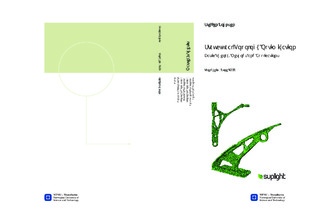| dc.description.abstract | The thesis is written as an introduction to topology optimization, aiming to help knowledge development in design optimization techniques, as well as aiding the adaptation of a sustainable culture with direct application to similar products like the two test cases supplied by the EC SuPLight project. These components are; a Door Connection Joint for a business jet and a Front Lower Control Arm from a McPherson suspension. The thesis has no intention of covering all aspects concerning topology optimization, but to investigate best practice and give advice on how to understand the process and how to setup an optimization run. The thesis is especially discussing how to make sure that results can be trusted and that they can be used in real life engineering applications. This is found to be a subject of both loading and boundary condition definitions, as well as choice of optimization algorithms and general approach.The thesis begins with an elaboration of basic topology optimization theory; discussing topology optimization history, mathematical algorithms, available software and general workflow when performing topology optimization. In particular, the widely used SIMP-algorithm and the MinMax approach are elaborated, as well as proposing solution strategies for obtaining suitable results, depending on the desired properties. The thesis further discusses the use of Abaqus ATOM for optimizing the two test cases, evaluating previously stated optimization solution strategies as well as manually performing multidisciplinary topology optimization on the Door Connection Joint. A process description of the NX topology optimization module is also included. Simulation results from minimizing volume and constraining displacements suggest geometries that for the Door Connection Joint and the FLCA are 11.2\% and 6.41\% lighter than the original parts, respectively. The thesis ends with an evaluation of the quality of results, ease of use and reliability of such optimization, as well as proposing significantly lighter, reengineered designs for both components. Reengineered geometries for the Door Connection Joint and FLCA are 7.11\% and 5.92\% lighter, respectively. Using topology optimization as an initial approach to expanding the solution space and finding the optimal solution is found to be very efficient, and use is expected to increase rapidly as knowledge and availability of tools increase. Pushing performance limits, topology optimization reduce product versatility, making the engineer's role in development just as important as before. | nb_NO |

